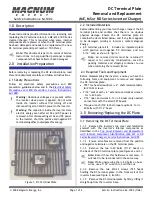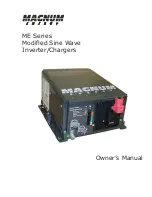
TP-6391 9/08
47
Section 5 Component Testing and Adjustment
5.3 Stator
The stator contains a series of coils of wire laid in a
laminated steel frame.
The stator leads supply AC
voltage to the load and voltage regulator. Before testing
the stator, inspect it for heat discoloration and visible
damage to housing lead wires, exposed coil windings,
and exposed areas of frame laminations. Be sure the
stator is securely fastened to the stator housing.
Note:
Disconnect all stator leads before performing all
stator tests.
Hazardous voltage.
Can cause severe injury or death.
Operate the generator set only when
all guards and electrical enclosures
are in place.
Moving parts.
WARNING
High voltage test. Hazardous voltage can cause severe
injury or death.
Follow the instructions of the test equipment
manufacturer when performing high-voltage tests on the rotor
or stator. An improper test procedure can damage equipment
or lead to generator set failure.
Short circuits.
Hazardous voltage/current can cause
severe injury or death.
Short circuits can cause bodily injury
and/or equipment damage
.
Do not contact electrical
connections with tools or jewelry while making adjustments or
repairs. Remove all jewelry before servicing the equipment.
Stator Continuity and Resistance Tests
1. Place the generator set master switch in the OFF
position.
2. Disconnect power to the battery charger, if
equipped.
3. Disconnect the generator set engine starting
battery, negative (--) lead first.
4. Disconnect all stator leads before performing all
stator tests.
5. To check for stator continuity, set the ohmmeter on
R x 1 scale. First set the ohmmeter zero by holding
the red and black meter leads together and setting
the ohmmeter reading to zero. Then check the
stator continuity by connecting the meter leads to
the stator leads as shown in Figure 5-4.
Note:
For single-phase models, leads 1--4 are the
generator output leads. Leads 11, 44, 55,
and 66 are the controller and SCR module
sensing and supply leads.
Refer to the
schematic in Figure 5-5 when performing
the following steps.
Note:
When taking an ohmmeter reading using
lead 55, make the connection before the
in-line fuse.
6. Contact the ohmmeter leads and readjust the
ohmmeter to read zero ohms.
7. Check the cold resistance of the stator windings by
connecting the meter leads to the stator leads. See
Section 1.4, Alternator Specifications, for stator
winding resistances.
Note:
Most ohmmeters do not provide accurate
readings below 1 ohm.
Low resistance
readings (continuity) and no evidence of
shorted
windings
(heat
discoloration)
indicate a stator in good condition.
See
Figure 5-6.
8. If the resistance test proves inconclusive, use a
megohmmeter to test the stator as described in the
next step.
Note:
Because
ohmmeter
accuracy
varies,
resistance
readings
are
approximate
readings. Take readings of the rotor and
stator at room temperature.
Note:
Make
sure
that
all
stator
leads
are
disconnected
before
running
the
megohmmeter test.
R14807-14
Figure 5-4
Testing Stator Windings
















































